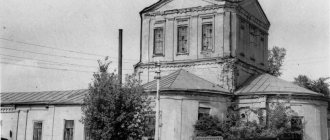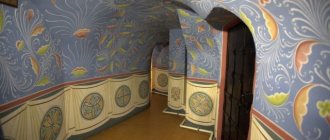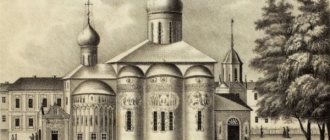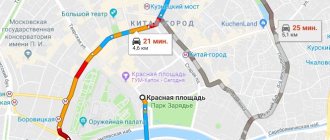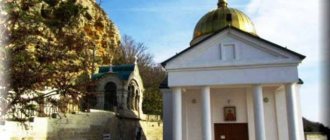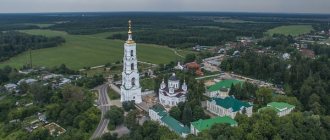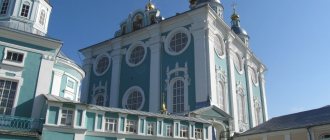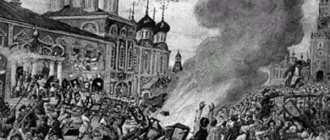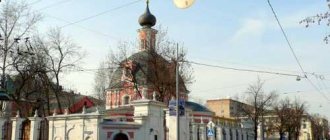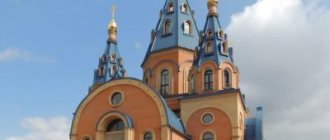The Chernigov skete (Cave branch of the Gethsemane monastery) in Sergiev Posad is a metochion of the Trinity-Sergius Lavra. Today the skete is a functioning monastery, where only 10 monks serve.
The church complex with a large stone Temple in the name of the Mother of God of Chernigov-Gethsemane once began with a small cave dug by Philippushka the Blessed. Restored according to descriptions of eyewitnesses and drawings, the underground altar, which served as a sewage pit in Soviet times, has regained its original appearance and attracts pilgrims and tourists from all over the world.
Historical events
The Chernigov monastery in Sergiev Posad was founded 3 km southeast of the Trinity-Sergius Lavra, on the northern shore of the Korbushinsky pond, by the hermit monk Filippushka Yurodiv in 1847. Opposite him, across the pond, was the Gethsemane monastery (founded in 1844 .), to which at the end of the 19th century. The Chernigov monastery was attributed.
Back in 1845, several monks of the Gethsemane monastery, inclined towards complete solitude and renunciation of everything worldly, began to build wooden cells in the Isakovskaya Grove, on the opposite bank of the pond.
The Holy Fool Philippushka (blessed Schemamonk Philip), who lived at the Lavra, having asked for a blessing to dig a “cellar”, in 1847 dug himself an underground cell. It was this year that began to be considered the date of the creation of the Chernigov monastery. Other monks began to dig “cellars” nearby. The first cave temple was a log half-dugout, consecrated in the name of the Ethereal Heavenly Forces.
The upper part of the temple had small windows, the lower, underground part was connected to neighboring caves by long, winding underground passages. The monks did all the excavation work by hand, in the most difficult conditions, with enormous humidity, suffocating from the heat in the summer and freezing in the winter. They say that 2 monks died in the collapses.
On September 27, 1851, the cave temple was renamed and consecrated in honor of Archangel Michael and other ethereal forces by Metropolitan Philaret. The icon of the Chernigov Mother of God was donated to the temple in 1852 by noblewoman Alexandra Grigorievna Filippova, in whose family the icon was kept for more than half a century.
The long and difficult history of the Skete is marked by important milestones:
- 1857 _ – the above-cave wooden church of St. Anthony and Theodosius of Pechersk was erected.
- 1921 _ - the monks were transferred to the Gethsemane monastery. The Chernigov monastery was turned into a prison, then a home for the disabled and warehouses were located here.
- 1990 – revival of the skete as a monastery assigned to the Lavra.
- Since 2007 Most of the monastery is occupied by a boarding school for disabled children. Number of monks from 2006 to 2009 reduced from 25 to 10 people.
Features of monastic life
In Russian Orthodoxy, since time immemorial, a tradition has developed: particularly zealous monks, having asked for a blessing from the abbot, leave the walls of the monastery and settle at a distance from it. Such care allowed them to concentrate more on prayer, avoiding everything worldly and vain that, one way or another, penetrates the walls of the monastery. Administratively, they remained assigned to the main monastery and obeyed its abbot in everything, but their chosen form of life made it possible to establish for themselves a more strict charter, built on the rules of the strictest asceticism.
Sometimes the monks settled in solitude and became hermits, but sometimes they, uniting several people, founded a small but independent monastery, called a monastery. This word itself comes from the name of the region of Egypt, in which, according to legend, monasticism originated, and from where it spread throughout the world.
Architecture, appearance
The Chernigov monastery in Sergiev Posad today is an architectural ensemble centered around the 5-domed stone Chernigov Temple. A large church was erected in the name of the Mother of God of Chernigov-Gethsemane in the period from 1886 to 1889. The cave church, which gave rise to the monastery, is located directly below the Temple.
In 1857, an underground refectory with a vaulted ceiling was added to the cave church from the west. From that moment on, the church began to be called an altar.
The design and construction of the stone above-cave Temple was carried out under the leadership of N.V. Sultanova. The ingenious architect was able to design a powerful foundation in damp, unstable soil, and build the walls of the temple without damaging the altar underneath. The cave church was active throughout the entire period of construction.
In addition to the Temple, the monastery complex includes:
- a chapel in the name of St. Vladimir of Serbia, built over the holy spring;
- 5-tier bell tower 71 m high, above the main entrance to the monastery;
- Church in the name of St. Nicholas the Wonderworker (north-west of the chapel);
- temple in the name of the pious Constantine and Helen (behind the chapel, to the right of it);
- 2-storey Southern cell building;
- 1-storey cell building along the eastern fence;
- 2-story refectory along the western fence;
- The Bogolyubskaya monastery, as a burial place for the schema-monk brothers, was founded by Blessed Filippushka in 1858, to the west of the monastery, on the shore of a nearby pond. Later, a 2-story stone church was erected above it.
The entire ensemble of the monastery is designed in a pseudo-Russian style, preserving the classical traditions of Old Russian architecture.
Sergiev Posad. Gethsemane Chernigov monastery today
Time has put everything in its place. Today, the Chernigov-Gethsemane monastery, as in previous years, receives a large number of people who want to visit this amazing place. In addition to the fact that it has been revived as a center of spiritual life, it is rightfully considered one of the most significant historical and cultural monuments. The architectural center of the complex is the Chernigov Church, built in 1889.
Below it is a cave temple, which marked the beginning of the construction of the monastery. Its refectory was significantly expanded in the last years of the 19th century, and in the part that the founder of the monastery, the holy fool Philippushka, created with his labors, today there is an altar. The temple has been completely restored and services are held there.
Interior decoration
The interior decoration of the Church of the Mother of God of Chernigov-Gethsemane amazes with its grandeur and beauty. Superbly executed frescoes, icons in expensive frames, a painted vaulted ceiling with images of the most revered saints, a shrine with the relics of St. Barnabas - at the sight of all this, your heart skips a beat, you want to speak in a whisper and turn to the Lord only with the most pressing problems.
At the entrance to the Temple, headscarves and skirts are offered; it is considered a sin for women to enter with their heads uncovered and in trousers. The underground cave temple is quite ascetic inside. There are also many icons here, the faces of saints look out from all the walls.
But everything was done in a simple and austere style, recalling that monks lived here in the harshest conditions, the strictest fasting and constant deprivation, whose whole life consisted of incessant prayers and self-torture. The vaulted walls in the corridors and cells are painted with ancient Russian ornaments, the floor is lined with thick tiles.
Chernigov Skete of Gethsemane in Sergiev Posad inside.
The perimeter of the monastery is surrounded by a red-brick wall of thick 0.5-meter masonry, with towers in the corners. The area is well-groomed, clean, divided into lawns, surrounded by fragrant flower beds. There are signs, warnings and explanatory signs everywhere.
In front of the gates of the monastery, the waters of the Gethsemane ponds, which once separated the Chernigov monastery from the Gethsemane monastery, glisten under the sun. Swans and ducks swim here, which visitors love to feed.
On the territory of the monastery there are two refectory-cafes, where monastic food, delicious pastries, aromatic and invigorating, yeast-free kvass, brewed using the monastery’s own technology, are offered. There is pine, spicy ginger, beet kvass.
In the church shop you can buy icons, blessed crosses and silver rings with the inscription “Save and Preserve.” They also sell gold wedding rings with words of protective prayer applied to the inner surface. The church shop accepts orders for tours of the caves. There is a stall with souvenirs.
Under the yoke of the atheistic government
In 1919, the atheistic campaign initiated by Lenin also affected Sergiev Posad. In November the Lavra was closed. By order of the city authorities, the inhabitants were obliged to move to both monasteries located near the Upper Skete Pond - Gethsemane and Chernigov.
But the monks did not live in them for long. In 1921, the Chernigov monastery was closed, and the miraculous icon located in it was transferred to the Moscow Church of St. Sergius of Radonezh. The Gethsemane monastery existed somewhat longer. During the NEP period, it was given the status of an agricultural community, and the monastery remained self-sufficient for some time.
However, already in 1924, the last church, consecrated in honor of the Dormition and Ascension of the Mother of God, closed, and soon this was followed by the eviction of the monks themselves from their habitable place. The last abbot of the monastery, Abbot Israel, was sent into exile, where he died in the early fifties.
Shrines
The Chernigov monastery in Sergiev Posad has amazing powerful energy. The place, prayed for by several generations of monks, has an aura of holiness; a feeling of peace and tranquility arises here. All problems suddenly lose their severity, and confidence in help from above arises.
There is no fuss and ostentatious piety here; the spirit of business from faith, which, unfortunately, many famous Temples are guilty of, has not yet penetrated here.
The following shrines are kept in the Chernigov monastery:
- The cathedral houses the main shrine of the monastery - the relics of St. Venerable Barnabas, numbered among the host of Radonezh saints. From the Hebrew "Barnabas" is translated as "son of consolation." He lived in the Chernigov monastery for 47 years, 33 of them in the guise of a holy elder. Pilgrims from all over Russia came to him, seeking consolation and strengthening of faith. He could receive and confess up to 500 people a day. In particular, Emperor Nicholas II himself came to him in 1905 along with his entire family. The abbot of the Trinity-Sergius Lavra called Barnabas “the people’s confessor.”
- The relics of Blessed Philippushka are buried in the lower church of the Bogolyubskaya Kinovia. Once upon a time, Philip Khorev, a peasant originally from the Vladimir province, had a family and children. But an insight that once visited him forced him to leave his established life, his family and go wandering around Rus'. Before settling in the monastery, he acted like a fool for many years. In winter and summer he walked barefoot, went hungry, wore beggarly cast-offs, and tormented himself by wearing chains. Filippushka lived on alms, was distinguished by an unusually meek disposition and the gift of prediction, he was called “visionary.”
- On the territory of the Skete there is the burial place of Alexandra Grigorievna Filippova, who once donated the icon of the Chernigov Mother of God to the monastery. She lived her last years in a nursing home at the monastery, prayed a lot, and religiously observed all church canons.
- People constantly approach the two main miraculous icons of the Temple and stand for a long time, fervently crossing themselves and whispering their prayers, many on their knees. The kandilo (candlesticks) in front of them are always full of burning candles: a list from the miraculous icon of the Chernigov Mother of God (September 14 - Patronal Feast). The icon first performed a miracle in 1869, healing a paralyzed woman in the Cave Church of the Chernigov Monastery. The ancient icon repeatedly showed miracles of healing, over 100 of them were recorded; the list from the Icon “The Unbreakable Wall” protects from the evil eye, damage, curses, from loss of property, and saves during a natural disaster, epidemic, or enemy invasion.
- The most important shrine of the monastery, revered and carefully protected, is one of 2 sacred stones, with Orthodox crosses carved on them, brought as a gift to the monastery from Jerusalem by the Russian historian and writer A.N. Muravyov. The surviving stone was taken by Muravyov in the Gethsemane cave, from the tomb of the Virgin Mary. The stone is inserted into the icon case, under it there is an explanatory inscription: “for the blessing of New Gethsemane.”
- The relics of the saints of the Kiev Pechersk Lavra are kept in a special reliquary in the cave temple. Pilgrims overcome by illnesses and misfortunes come to venerate them.
- At the entrance to the temple there is an icon of the Mother of God “Praying”. They pray before her to gain and strengthen faith.
- To the north of the main Cathedral on the territory of the monastery there are burial places of monks, trustees and benefactors. Here lie the remains of famous Russian publicists and philosophers:
- Konstantin Nikolaevich Leontyev (doctor, diplomat, writer and philosopher, who became a monk under the name Clement);
- Vasily Vasilyevich Rozanov, Russian religious philosopher, thinker and writer.
Interesting facts and legends
Interesting facts that have become legends in the history of the monastery over many years:
- Nicholas II personally came to Barnabas of Gethsemane (canonized in 1995). They talked for a long time in private. They say that Barnabas then predicted a painful death for him and his entire family and the death of the Romanov royal dynasty.
- They say that the Chernigov monastery and the Gethsemane monastery were once connected by an underground passage dug by monks and giving them the opportunity to freely go to the Chernigov monastery to worship in the cave temple.
- Parishioners, who came to the monastery not for the first time, claim that the number of angels surrounding the Mother of God in the “Unbreakable Wall” icon is gradually increasing, the holy faces seem to appear on the icon. No one can reliably confirm this miracle, but everyone looks carefully at the icon and tries to count the angels.
- The paths to the Skete are lined with tombstones from the old skete necropolis, destroyed under the Bolsheviks.
Opening hours and schedule of services
The Chernigov monastery in Sergiev Posad is visited by dozens and hundreds of believers every day.
The cathedral holds daily services:
- 5.30 (at dawn) - a general prayer service in front of the shrine with the relics of St. Barnabas;
- 6.30 morning - divine liturgy (Eucharist);
- 11.00 - Akathist at the icon of Our Lady of Chernigov;
- 12.00 — unction (anointing with oil);
- 16.45 - evening liturgy.
Unction in the Skete is performed daily, with the exception of major holidays and Sundays. The sacrament begins at 12.00, it lasts about 2 hours. It is recommended to arrive at the unction service 0.5 hours before the start to sign up and buy a cathedral candle.
In addition to unction, other services and sacraments are served in the Skete:
- magpies;
- wedding;
- baptism;
- funeral service (of the dead);
- commemorations (for health and for repose) - for six months and for a year;
- prayer services.
Every day, from early morning until late evening, replacing each other, the monks read the psalter in front of the lectern. Many pilgrims want to confess and take communion at the Chernigov monastery. This can be done during the daily morning and evening services. In the Bogolyubskaya Kinovia, on weekdays and Saturdays the Divine Liturgy is served at 7.00, on Sunday the service begins at 9.00.
Official portal on the Internet
The official website of the Chernigov Monastery provides complete information about the history of the monastery, its
shrines and ascetics. Every visitor to the monastery can ask a question using a special form.
A separate section contains sermons and instructions from the elders who lived in the monastery. There is a Sunday school at the Chernigov monastery, which is attended by the children of local residents.
The monks of the monastery have their own confectionery production
. There are a variety of pastries, cakes and pastries on sale.
In addition, here you can buy monastery honey, flaxseed oil, sauerkraut and other locally made products. All proceeds from the sale go to restore and pay for restoration work in the monastery.
The photo and video gallery presents images of the past and present appearance of the monastery. Thanks to the official portal, believers who are not able to visit the monastery on their own can get to know it better and make a donation.
On the official website of the Chernigov Monastery you can always find the current schedule of services held in the Chernigov monastery. Liturgy is usually celebrated daily - at 6.30 on weekdays and at 8.30 on Sundays. On the same day at 7.30 a prayer service with Akathist to St. Barnabas is served. The evening service begins around 17.00.
Dungeon tours
The monastery staff, the monks, are very friendly, humbly meek and somehow especially calm and attentive. The excursions are conducted by seminarians from the Trinity-Sergius Lavra. They tell the history of the Skete in detail, with love and respect, show all the relics, and will readily answer any question regarding the most private details.
Those who have been to the Skete more than once say that each seminarian tells his own story, adding his own details to his excursion.
A tour of the Skeet caves attracts everyone; most tourists come here precisely for this. In total, 14 small cells and two large halls were dug underground, at a depth of 6.5 m. The smallest cell is only 2 m long and 1 m wide. Now the caves have been completely restored.
Cost of a group tour of the caves for Russians:
| group size (persons) | adults, up to 10 | adults, over 10 | schoolchildren, up to 10 | schoolchildren, over 10 |
| Cost, rub.) | 800 (per group) | 80 (per person) | 800 (per group) | 40 (with 1 person) |
Cost of a group tour for foreign citizens:
| group size (persons) | adults, up to 10 | adults, over 10 | schoolchildren, up to 10 | schoolchildren, over 10 |
| Cost, rub.) | 1000 (per group) | 100 (with 1 person) | 1000 (per group) | 50 (with 1 person) |
If there are wheelchair users in the group, please inform us in advance, the brother monks will help with the movement of the disabled person around the territory of the Skete. After the excursion, you can independently walk around the monastery, go to the Temple, pray at the miraculous icons, submit notes for health and peace, and light candles.
A holy underground spring, gushing from a depth of 20 m, fills a small underground lake (Gethsemane well). Next to him is a font of holy water. It is believed that by bathing in it, you can remove all your sins and be healed of illnesses.
However, the water is so cold (+4 degrees) that few dare to plunge into it. The font is divided into male and female halves. The chapel in the name of St. Vladimir of Serbia, next to the font, is open daily from 5.00 to 21.00.
How to get there by car, public transport
The Chernigov monastery, a monastery founded by hermit monks in 1844 in ancient Sergiev Posad, is located quite far from the city center. The trip takes 15 minutes by bus No. 38, get off at the Kalyaevskaya sign. Take minibus No. 7, 18 to the village “Ferma”.
You can get to the village “Loza” (minibuses No. 30,36,37), exit in front of Ferma, at the checkpoint. Then you should cross to the other side of the road, turn north and walk along Solnechnaya Street.
The road will lead to the monastery. Driving route from Lavra:
- turn from Red Army Avenue onto Karl Marx Street;
- at the 2nd intersection behind the railway section, turn left onto Vifanskaya Street;
- turn onto Novogorodnaya;
- after the sign “NIIRP” turn right;
- then drive in a straight line, without turning, to Skeet.
A taxi from the city center will cost approximately 200 rubles. Near the Chernigov Skete there are 2 free, quite large parking lots. From Lavra to Skete it is only 3 km; at a leisurely pace it will take about 40 minutes.
Bus No. 388 runs from Moscow (from the VDNH metro station) to the final stop of Sergiev Posad. The electric train to Sergiev Posad departs from the Yaroslavsky station. It takes longer, from the railway station in Sergiev Posad to the monastery by minibuses No. 7, 8.
Post-war years
At the end of the war, Sergiev Posad was one of the few cities where monastic life was revived. In 1946, by order of the government, the Trinity-Sergius Lavra was reopened, where the first divine service was held in the Assumption Cathedral on Maundy Thursday. However, there was no talk of returning the monasteries taken from them to the monks. Since the early fifties, a military unit has been located on the territory where the Gethsemane monastery was previously located. To improve it, all the monastery buildings that had survived until that time were blown up. Only a small part of the fence survived.
The fate of the Chernigov monastery was no less sad. During the period of Soviet power, it was used for a long time as a prison, and then as a boarding school for the disabled. Only in 1988, when state policy towards the church changed, did the process of its revival begin. In this regard, on the initiative of the Moscow Patriarchate and with the participation of Orthodox activists, a special committee was established.
